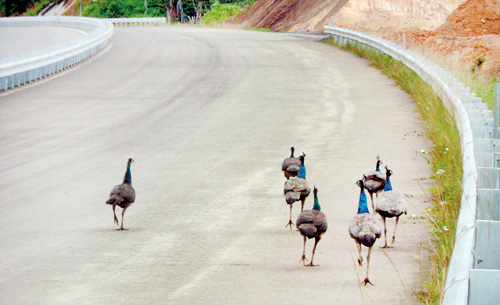News
Religious beliefs save Mattala peacocks, but threat persists
Hundreds if not thousands of peacocks pose a serious threat to airline traffic at the Mattala Rajapaksa International Airport (MRIA) but authorities are unable to eliminate this bird population owing to local religious beliefs, a senior Aviation official said yesterday. Since peacocks were revered by both Buddhists and Hindus, the task of eradicating the menace had become even more difficult, Civil Aviation Director General H. M. C. Nimalsiri said.
He said one permanent solution would be to carry
out a mass-scale culling of the peacocks but this is bound to raise a storm of protests from people and religious leaders from across the country.
In addition these birds are not killed for meat and this was another reason for their increase in population not only at Mattala but also close to airfields in the north and east, he said.
The Mattala airport is situated close to the sacred city of Kataragama and devotees believed that the peacock was the vehicle used by the god of that city, Mr. Nimalasiri said. Meanwhile the authorities have assured foreign airline operators that it is safe to use the MRIA. The assurance comes after last Saturday’s incident where an aircraft of the Dubai-based budget airline Fly Dubai was forced to make an emergency landing after two peacocks collided with it, a senior official said yesterday.
“We have sent out a strong assurance to all airlines using the MRIA that there will be no recurrence of the incident as precautionary and safety measures have been taken,” Mr. Nimalsiri said. He said additional measures that include an increase in runaway patrols that are used to scare away wild life in and around the airport complex were being implemented. In addition the scrub jungle in the area was also being cleared to discourage the wildlife from making it their permanent habitat.
A special committee made up of wild life experts, environmentalists and aviation officials has also been set up to work out a permanent safety mechanism, Mr. Nimalsiri said.
He denied reports that several foreign airline operators were planning to pull out, citing safety reasons. “There is no truth in this. Airlines continue to use the MRIA and we have assured them of the fullest safety conditions at all times despite the recent developments,” he said.
Meanwhile wildlife experts and activists warned of a disaster unless the authorities addressed the matter with the utmost seriousness and at the very earliest.
Colombo University’s zoology lecturer Dr. Devaka Weerakoon said the authorities must draw up a serious wild life management plan.“Incidents where wildlife has interfered with flying aircraft are common all over the world, but the situation in Mattala is different since the complex is situated in and around the flight path of thousands of migratory birds and other animals,” he said.
The planners at Mattala were in a hurry to complete the airport without heeding advice given at that time relating to the presence of the birds and the wildlife, Dr. Weerakoon who was consulted during the feasibility study for an airport project in Weerawila said. He said the conditions at Weerawila were better owing to the low density of the forest cover and the lesser number of wildlife and birds in the area but for some reason the project was shifted to Mattala.
He further added that studies have revealed that some 90 per cent of incidents involving birds and aircraft had taken place about 500 metres from ground level — that is during take-off. He also warned that should there be an increased in air traffic at the MRIA, it is bound to double the threat as the birds and wildlife would get more and more restless and this could could lead to a dangerous situation.
His views were endorsed by leading environmentalist Jagath Gunawardene who said that the MRIA was in the middle of the Eastern Bird Migratory Path (EBMP) where there was a lot of activity between September-October and March-April each year. He said that the clearing of the forest cover had attracted a large number of ground dwelling birds including peacocks and that was the source of the problem. “I raised this matter in 2007 when the feasibility report was being done but no one was ready to listen. We must not only be concerned about the birds and the wildlife but also human lives,” he added.
Prancing peacocks on highway

A week after two peacocks were killed at Mattala airport after a collision with an aircraft, a pride of peacocks is seen on the newly extended stretch of the Southern Expressway yesterday. They are unaware of the potential danger when speeding vehicles whiz past their habitat. Pic by Krishan Jeewaka Jayaruk

